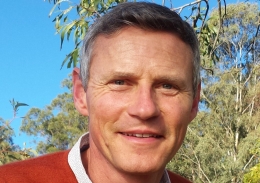Incremental change is not enough if we want to limit temperature rises to 1.5°C, says the IPCC’s Working Group III, which includes UNSW sustainability expert Tommy Wiedmann.
The latest report by the Intergovernmental Panel on Climate Change (IPCC), released overnight, was delivered with a bleak warning: limiting temperature rises to 1.5°C is beyond reach without significantly reducing emissions immediately.
But the good news is that thanks to advances in renewable energy technologies that have become vastly cheaper in the last decade, it is possible that greenhouse gases can be halved by 2030 – meaning the Paris Agreement goals would still be achievable.
The report, titled Climate Change 2022: Mitigation of climate change, was written by 278 scientists from 65 countries that comprised IPCC’s Working Group III. It revealed that in the 10 years from 2010-2019, average annual global greenhouse gas emissions were at their highest levels in human history, although the rate of growth has slowed.
Professor Tommy Wiedmann, an expert in sustainability at UNSW Sydney and an author of the report, said a modest reprieve in emissions caused by the COVID-19 pandemic was sadly only short-lived.

Professor Tommy Wiedmann
“There was a drop of about 6 per cent in 2020 because of COVID-19,” he said. “But last year, emissions increased again to about the same level as in 2019.
“Some greenhouse gas-intensive activities have grown particularly fast between 2010 and 2020. For example: sales of sports utility vehicles went up 17 per cent, aviation increased 29 per cent. And energy demand for cooling in residential buildings went up 40 per cent.”
But there have been some improved outcomes in this timeframe, Prof. Wiedmann said. The costs of renewable energy have drastically reduced, a trend that could pave the way towards meeting future emissions targets.
“Since 2010, there have been sustained decreases of up to 85 per cent in the costs of solar and wind energy, as well as batteries.”
This sentiment was echoed by IPCC Chair Hoesung Lee, who said on the release of the report that while the world is certainly at a crossroads, the know-how required to limit warming is in the hands of world leaders and climate experts.
“I am encouraged by climate action being taken in many countries,” said Chair Lee.
“There are policies, regulations and market instruments that are proving effective. If these are scaled up and applied more widely and equitably, they can support deep emissions reductions and stimulate innovation.”
We have options in all sectors to at least halve emissions by 2030
The IPCC said in its report that limiting global warming will require major transitions in the energy sector including a substantial reduction in fossil fuel use, widespread electrification, improved energy efficiency, and use of alternative fuels such as hydrogen.
“Halving emissions by 2030 is very doable, but it requires serious commitment to climate goals,” said Prof. Wiedmann.
“We can do this with solar and wind energy, energy efficiency improvements, reduced deforestation, soil carbon storage and methane emissions reductions.
“In the near- and medium-term, the halving-by-2030 target could be reached through changes across transport, industry, buildings and land-use.”
IPCC Working Group III Co-Chair Priyadarshi Shukla said if this trajectory were to continue, the world could see emissions reduce even further in coming decades.
The slow pace of change and entrenched inequality
However, Prof. Wiedmann said the world still had a long way to go.
“Change is not coming fast enough,” he said.
“All the gains we made in energy efficiency in the last decade have been more than outpaced by economic growth and population growth. And economic growth is twice as strong as an upward driver of emissions than population growth.”
One of the downsides to economic growth among the world’s richest nations is the resulting problem of inequality. According to the report, the richest 10 per cent of world’s households – including those in Australia – contribute about 40 per cent of global greenhouse gas emissions while the bottom 50 per cent contribute less than 15 per cent.
“And half of all emissions from aviation are caused by the top 1 per cent alone,” Prof. Wiedmann said.
He argues that at the higher end of the inequality spectrum, this points to the problem of high consumer demand and over-consumption. And that making simple lifestyle changes in developed countries could reduce greenhouse gas emissions decisively. Together with the right policies, infrastructure and technology in place to enable changes to our lifestyles and behaviour, these changes could result in a 40-70 per cent reduction in greenhouse gas emissions by 2050.
“This would include things like shifting to plant-based diets, active and public transport, less flying, sharing living space and products, but also energy and material efficiency,” Prof. Wiedmann said.
The way cities should change
Cities and other urban areas also offer significant opportunities for emissions reductions, the report says. These can be achieved through lower energy consumption (such as by creating compact, walkable cities), electrification of transport in combination with low-emission energy sources, and enhanced carbon uptake and storage using nature.
“We see examples of zero energy or zero-carbon buildings in almost all climates,” said IPCC Working Group III Co-Chair Jim Skea. “Action in this decade is critical to capture the mitigation potential of buildings.”
Agriculture, forestry, and other land use can provide large-scale emissions reductions, the report says, and also remove and store carbon dioxide at scale. However, land cannot compensate for delayed emissions reductions in other sectors.
The next few years are critical
In the scenarios assessed by Working Group III, limiting warming to around 1.5°C requires global greenhouse gas emissions to peak before 2025 at the latest, and be reduced by 43 per cent by 2030. At the same time, methane would also need to be reduced by about a third. Even if this was done, it is almost inevitable that we will temporarily exceed this temperature threshold before returning to below it by the end of the century.
“It’s now or never, if we want to limit global warming to 1.5°C,” said Professor Skea. “Without immediate and deep emissions reductions across all sectors, it will be impossible.”
The global temperature will stabilise when carbon dioxide emissions reach net zero. For 1.5°C, this means achieving net-zero carbon dioxide emissions globally in the early 2050s; for 2°C, it is in the early 2070s.
This assessment shows that limiting warming to around 2°C still requires global greenhouse gas emissions to peak before 2025 at the latest, and be reduced by a quarter by 2030.
“Overall, this latest report from the IPCC reiterates the need for transformational change if the aims of the Paris Agreement are to be achieved, practically in every sector in every region. Incremental change is not sufficient,” said Prof. Wiedmann.







